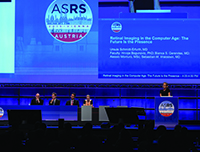IN BRIEF | |
| • Eylea injection (aflibercept, Regeneron Pharmaceuticals) has undergone safety labeling changes per a Food and Drug Administration (FDA) directive. The changes add a warning that reproductive-age women should use contraception before the initial dose, during treatment and for at least three months after the last intravitreal injection of Eylea. • Becton-Dickinson 3- and 5-ml syringes are the subject of an FDA alert to health professionals. The FDA warned professionals not to administer compounded or repackaged drugs stored in the syringes, unless they cannot find a suitable alternative. The FDA said preliminary information indicated drugs stored in these syringes may lose potency over time due to a possible interaction with the rubber stoppers. Using a substitute product may require a dosage adjustment in cases where the patient has received a subpotent agent. • Ampio Pharmaceuticals’ low-dose danazol agent Optina showed improvements in visual acuity when study subjects used it with a common diabetes medication, according to further data analysis from the 12-week trial. Among study patients, 69 percent received ACE inhibitors (angiotensin converting enzyme) or ARBs (angiotensin receptor blockers) to manage kidney-induced high blood pressure. When this group received the optimal Optina dose, they showed a 6-letter improvement compared to placebo, regardless of whether or not they previously had intravitreal anti-VEGF treatments. |
Biosimilars are to branded biologic agents like Lucentis what generics are to branded small-molecule drugs.
In ophthalmology, and specifically for biosimilars of Lucentis, the windows may be closing for competitors in the United States. Two companies, Pfenex and Apotex, are working to develop a biosimilar form of Lucentis for the U.S. and European markets, according to Ronny Gal, an analyst at Bernstein who follows biologics. Lucentis comes off patent in the United States in 2020 and in Europe in 2022, says Mr. Gal. But copying ranibizumab may be a risky venture because of “clinical obsolescence” of the index biologic, Mr. Gal says.
The biosimilars sector may have received a boost earlier this year when Sandoz’s Zarxio (filgrastrim) became the first biosimilar agent the Food and Drug Administration approved via a streamlined application pathway enacted in 2009. Zarxio got approved for all the indications of its reference biologic, Amgen’s Neupogen, an agent approved for five different indications ranging from chemotherapy-induced neutropenia to severe chronic neutropenia.
But for biosimilars, the regulatory process is fraught with uncertainty, according to two speakers at the Biosimilars 20/20 conference in Philadelphia in June.
Getting approval for all the index agent’s indications, as Zarxio did, is no longer a given for biosimilars going forward, Steven Miller, MD, MBA, senior vice president of Express Scripts, said at the conference. “A couple of months later, we no longer have full extrapolation,” he said.
And the pace of approvals is painstaking, said Gillian Woollett, MA, DPhil, senior vice president for Avalere Health and former vice president of the Pharmaceutical Research and Manufacturers of America. “The FDA expects to approve 11 biologics this year,” she said. “If the FDA continues to approve at a rate of 11 biologics a year, with nearly 1,000 in development, it will take 100 years to get those in the pipeline today approved.”
Intas is also the only company from India to have launched a biosimilar in the highly regulated European market and is also the only company from India to have two of its biosimilars filed for registration in the United States. The company expects to launch its first U.S. biosimilar within the next 12 months, a company spokesman says.
1,500-plus Converge On Vienna for ASRS
More than 1,500 retina specialists and other attendees at the 33rd annual meeting of the American Society of Retina Specialists in Vienna took in hundreds of scientific papers, posters and, among the multitude of presentations learned that fundus autofluorescence can track the yearly progression of atrophic lesions in Stargardt’s disease (STGD) and show the lesions progress at about one-third of the rate of age-related macular degeneration.

annual meeting of the American
Society of Retina Specialists in Vienna.
Other ASRS award recipients are:
• Pyron Award to Gary W. Abrams, MD, professor at Kresge Eye Institute, Wayne State University School of Medicine in Detroit. His talk was titled, “Vision Restoration Strategies for Retinal Degenerations.”
• Founders Award to Richard F. Spaide, MD, of Vitreous-Retina-Macula Consultants of New York, who delivered the address, “Optical Coherence Tomography Angiography: The Reality Today and the Potential for the Future.”
“Against the backdrop of the magical ‘City of Music,’ home to Mozart, Beethoven, Brahms and more, 165 podium presentations were given, including 104 papers, 30 expert panel discussions, 24 medical and surgical cases, nine instructional courses, three invited symposia, 295 posters and 29 presentations on demand,” ASRS President Tarek S. Hassan said.
Dr. Scholl reported on results from the multicenter ProgStar studies that aim to describe the natural history of Stargardt’s disease and develop new outcome measures for clinical trials.
The retrospective study involved 442 eyes of 243 study participants and graded images from 204 eyes of 11 participants for two (n=159) or three (n=45) visits. At the first visit, 73 eyes exhibited areas of definitely decreased autofluorescence (DDAF). The study estimated progression of DDAF in those 73 eyes at 0.54 mm2 per year. The cumulative incidence of DDAF in the 131 eyes without DDAF at the initial visit was 24.4 percent by the end of the follow-up period.
“Fundus autofluorescence may serve as a monitoring tool and areas of DDAF as an outcome measure for interventional clinical trials in STGD that aim to slow down disease progression,” Dr. Scholl said. Meanwhile, the ProgStar studies are evaluating spectral-domain optical coherence tomography and functional measures such as microperimetry for additional outcome measures, Dr. Scholl said.
“The ASRS meeting in Vienna was an exceptional educational forum allowing an open and collegial international forum for discussing retinal diseases,” scientific program chair Mark Humayan, MD, PhD, said afterward. RS



